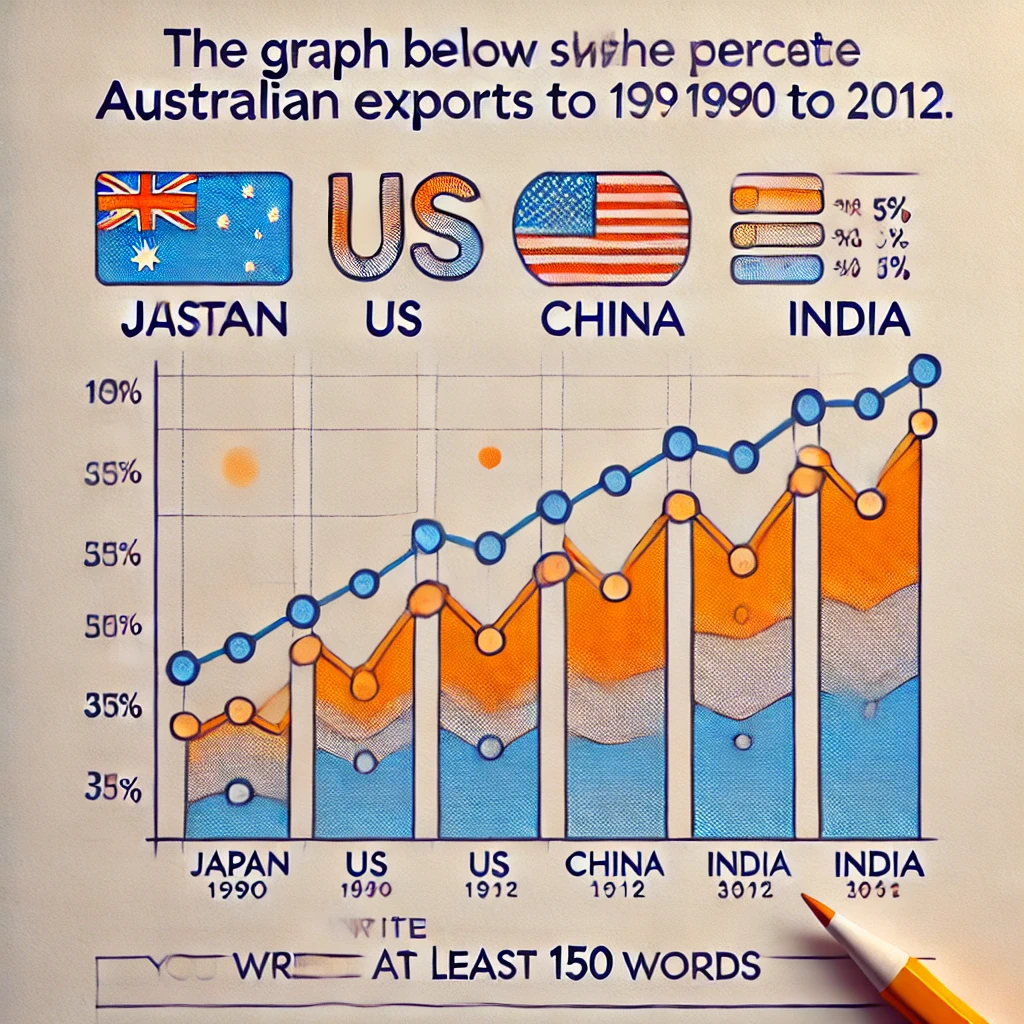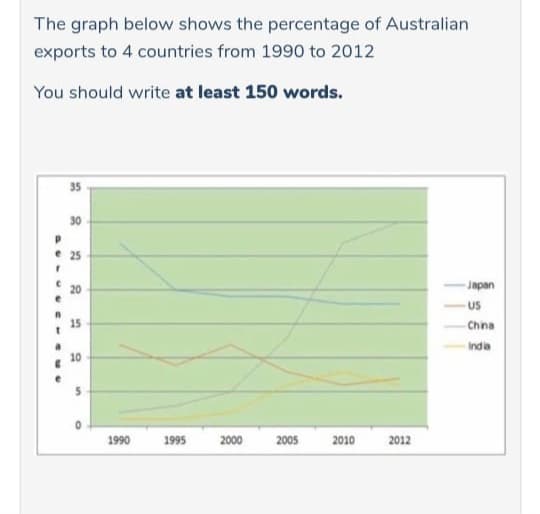The graph below shows the percentage of Australian exports to 4 countries from 1990 to 2012. You should write at least 150 words.
The line graph illustrates the percentage of Australian exports to four countries; Japan, the US, China, and India from 1990 to 2012. The data highlights how the exports shifted over this period between Australia and these four countries.
Overall, China emerged as the dominant destination for Australian exports by 2012, showing a sharp upward trend, while Japan, once the leading partner, experienced a notable decline in exports. Meanwhile, the US maintained a relatively stable share of exports throughout these years. India, however, consistently remained the smallest trading partner with minor fluctuations.
At the start of the period, Japan was the major destination for Australian exports, accounting for around 27% in 1990. However, by 2012, Japan’s share had dropped to approximately 17%. At that point of time China witnessed a remarkable surge in its exports to Australia. China’s exports started at about 5% in 1990 but rose steadily after 2000, eventually reaching around 30% in 2012. Therefore, China became the largest export destination for Australia by the end of the period.
In contrast, India consistently ranked as Australia’s minor trading partner. Starting at just around 2% in 1990, India’s share experienced slight growth. In the early 2000s, the India’s exports increased at around 6-7%, and then declined again to approximately 5% in 2012. This trend in exports kept India at the bottom compared to the other three nations.
Comparing the US to China, the US maintained a stable but lower export partner, fluctuating around 10-12% throughout the entire period. Whilst China’s rapid economic growth triggered its demand for Australian exports. The US’s demand, somehow, remained relatively stagnant, keeping it in the middle position between Japan and India.
As far as Japan’s exports are concerned, the country went through a declining trend in contrast to China’s. Japan’s importance decreased particularly after 2000.
At the same time, India’s weak performance, despite minor upward progress made it Australia’s smallest export destination throughout the period.
In conclusion, China’s major role in trade with Australia, Japan’s decline, and India’s minor role collectively highlight the shifting market dynamics Australia experienced over the period of two decades.“The graph below shows the percentage of Australian exports to 4 countries from 1990 to 2012. You should write at least 150 words.”
The line graph illustrates the percentage of Australian exports to four countries; Japan, the US, China, and India from 1990 to 2012. The data highlights how the exports shifted over this period between Australia and these four countries.
Overall, China emerged as the dominant destination for Australian exports by 2012, showing a sharp upward trend, while Japan, once the leading partner, experienced a notable decline in exports. Meanwhile, the US maintained a relatively stable share of exports throughout these years. India, however, consistently remained the smallest trading partner with minor fluctuations.
At the start of the period, Japan was the major destination for Australian exports, accounting for around 27% in 1990. However, by 2012, Japan’s share had dropped to approximately 17%. At that point of time China witnessed a remarkable surge in its exports to Australia. China’s exports started at about 5% in 1990 but rose steadily after 2000, eventually reaching around 30% in 2012. Therefore, China became the largest export destination for Australia by the end of the period.
In contrast, India consistently ranked as Australia’s minor trading partner. Starting at just around 2% in 1990, India’s share experienced slight growth. In the early 2000s, the India’s exports increased at around 6-7%, and then declined again to approximately 5% in 2012. This trend in exports kept India at the bottom compared to the other three nations.
Comparing the US to China, the US maintained a stable but lower export partner, fluctuating around 10-12% throughout the entire period. Whilst China’s rapid economic growth triggered its demand for Australian exports. The US’s demand, somehow, remained relatively stagnant, keeping it in the middle position between Japan and India.
As far as Japan’s exports are concerned, the country went through a declining trend in contrast to China’s. Japan’s importance decreased particularly after 2000.
At the same time, India’s weak performance, despite minor upward progress made it Australia’s smallest export destination throughout the period.
In conclusion, China’s major role in trade with Australia, Japan’s decline, and India’s minor role collectively highlight the shifting market dynamics Australia experienced over the period of two decades.
📍 English Language Educator | Blogger & Content Strategist | 7+ Years in Educational Blogging
Nosheen Bashir is a dedicated English teacher and experienced blogger with over seven years of expertise in content creation and educational writing. Passionate about language, literature, and effective communication, she combines her teaching experience with blogging skills to create insightful, research-backed content that helps learners and educators alike.
🔹 Expertise & Achievements:
✔ English Language Education: A skilled educator with years of experience in teaching English grammar, literature, and communication skills to students of varying levels.
✔ Educational Blogging: Running a successful blog for 7+ years, delivering well-structured, engaging content on language learning, writing techniques, and academic success.
✔ SEO & Content Strategy: Specializes in creating high-ranking, authoritative articles that follow Google’s EEAT principles, ensuring content that is both informative and search-friendly.
✔ Student-Centric Approach: Committed to making English easier, engaging, and accessible, helping readers and students improve their language proficiency.
🚀 With a passion for teaching and writing, Nosheen Bashir is dedicated to crafting educational content that empowers students, teachers, and language enthusiasts worldwide.









